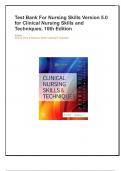Exam (elaborations)
Test Bank For Nursing Skills Version 5.0 for Clinical Nursing Skills and Techniques, 10th Edition Authors Anne G. Perry & Patricia A. Potter & Wendy R. Ostendorf
Test Bank for Nursing Skills Version 5.0 for Clinical Nursing Skills and Techniques, 10th Edition – Your Essential Nursing Exam Companion Prepare for success in your nursing studies with the Test Bank for Nursing Skills Version 5.0 for Clinical Nursing Skills and Techniques, 10th Edition. This...
[Show more]



